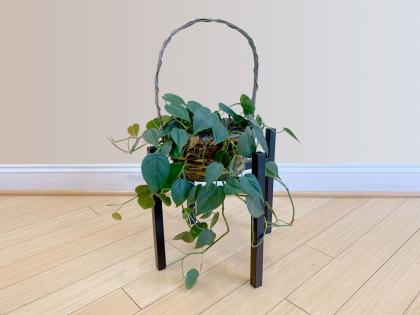It's easy to fall in love with houseplants—they brighten up a room and usher in a bit of the outdoors, providing us with connections to nature and the world. It's also easy to want more houseplants, but the cost of plant shopping can add up quickly. Learning how to propagate pothos and philodendrons offers a cost-efficient, do-it-yourself method of growing your own little slice of nature.
Plants, like all organisms, have the primary objectives of survival and reproduction. When we propagate, we trick a portion of a plant (typically in the form of a “cutting”) into believing that death is imminent, while providing the necessary water and light for it to rejuvenate. With everything it needs, the plant cutting will develop its own roots, leading to additional growth and the formation of a new, independent plant.
While many houseplants can be propagated in a variety of ways, two superstars were born to propagate: the heartleaf philodendron and pothos. Both respond very well to propagation and are great selections for those new to houseplant care. The same method can be used on both plants, as they both grow in a vine-like manner. For best results, only propagate mature, healthy plants free of disease and pests.
Pothos vs Philodendron: Spotting the Subtle Differences
While propagating pothos and philodendron might follow similar steps, it's fascinating to note the subtle differences between these two beloved houseplants. Understanding these distinctions not only enhances your gardening experience but also ensures you provide the right care for each.
Leaf Shape and Texture
One of the most striking differences is in their leaves. Pothos leaves are typically heart-shaped, with a glossy, waxy texture. Philodendron leaves, however, often come in a wider variety of shapes and have a softer, more matte finish. This variation adds a unique touch to each plant, allowing you to choose the one that best complements your home's decor.
Growth Patterns and Stem Structure
Pothos plants tend to have a cascading growth habit, perfect for hanging baskets or draping over shelves. Philodendrons, in contrast, grow more upright and can benefit from support like moss poles for vertical growth. The stems of pothos are thicker and more robust, while philodendron stems are slimmer and more pliable, a difference that becomes more apparent as the plants mature.
Rooting and Propagation
Both plants are excellent for propagation, especially in water. However, pothos usually roots faster in water compared to philodendrons. This slight variance is an interesting aspect for those who enjoy observing the nuances of plant growth.
Environmental Preferences
Philodendrons generally prefer a bit more humidity, making them a great choice for bathrooms or kitchens. Pothos, being more tolerant of dry air, offers more flexibility in placement around your home.
How to Propagate Pothos or Philodendron
Step 1: Select Your Cutting
Mature philodendron and pothos plants feature long, leafy vines originating from a central root system in the soil. To begin propagating a new plant, a portion of the vine will be cut. All plants must undergo photosynthesis to generate energy, so a minimum of two leaves should remain on the cut stem. For best results, select a longer, healthy vine with three leaves on the same stem. New leaf growth can be considered fully developed for propagation purposes. From the end of your vine, trace the stem three or four leaves closer to the root system.
Step 2: Make Your Cut
About half an inch below the last leaf nodule of your selected stem (the leaf closest to the root system), carefully use a sharp blade to separate the cutting from the main pothos or philodendron plant. Cutting at an angle may provide better results. Remove your new cutting.
Step 3: Remove the Last Leaf
On your new cutting, take your blade and carefully remove the last leaf on the stem, closest to the original cut. Do not remove any main stem, as this is where new roots will generate. Both the pothos and philodendron plants generate roots from nodes—small bumps on the main stem. In mature plant vines, nodes develop into leaves, which is why we remove the last leaf and provide an opening for a new root system.
Step 4: Prepare Rooting Solution
The easiest way to propagate pothos and philodendron plants is in water. To give your new cutting a root-development boost, use Natural Alternative® Protilizer® Seed and Plant Activator. Protilizer® provides beneficial microbes to develop healthy roots in new and established plants, making it ideal for a propagation needing to start roots from scratch. Mix about half a teaspoon of Protilizer® with one cup of clean water. If your tap water is high in chlorine, consider using distilled water or boiling tap water for 15 minutes prior to use. Ensure your water is at room temperature before mixing your Protilizer® solution. After adding Protilizer®, the water will appear brown—this is normal and healthy for the new cutting.
Step 5: Begin Growing Your New Pothos or Philodendron
Pour the Protilizer® solution into a clean container—a cup works just fine. Place your new cutting into the solution, submerging the node exposed by the cut in step three. Do not submerge the remaining leaves in the solution. While both the pothos and heartleaf philodendrons will survive in low-light conditions as mature plants, new cuttings require more light. For best results, select an area of your home or office that receives bright, indirect light. Direct sunlight may burn young cutting, so avoid placing your cutting in windows that receive continuous, unfiltered sunlight.
Step 6: Monitor Your Cutting - Propagating Pothos In Water
After about a week, the Protilizer® solution will need to be exchanged for fresh, new water. Remove the Protilizer® solution from your propagation container, rinse the container with water and add new water. Depending on your conditions, roots may take as little as a week to begin showing. If your cutting features fewer leaves or is in low light, expect slower root growth. Leave your cutting in its propagation container, change the water weekly, and monitor for root growth.
Step 7: Plant Juvenile in Soil
Identifying when a cutting is ready for soil can be the trickiest step of propagation. Left too long in a water solution, a cutting will have difficulty adapting to soil. Planted too early, and the cutting won't have sufficient roots for water intake. Often, pothos and heartleaf philodendron cuttings will quickly develop one main root in water. Allow this root to grow and develop smaller, often lighter side roots before planting. Your cutting is ready to be transferred to soil when the side roots have developed about a quarter of an inch in length. Place your cutting into soil mix pre-moistened with Protilizer® solution, in a smaller, well-draining container.
Step 8: Weaning the Juvenile Pothos or Philodendron
Because your cutting began development in water, it is important to keep the new cutting moist in soil for the first few weeks. Lightly water your cutting approximately every other day for about a week, monitoring for any discoloration or changes in appearance. Slowly cut back on watering frequency as the cutting adapts to its soil environment.
Wilting or yellowing leaves can be a sign of insufficient watering, so be sure to check the soil for moisture levels. If new growth appears at the end of the cutting, your propagated plant is happy and thriving! After a few weeks, your plant should be used to its new home and is now an independent houseplant.
If your new plant is moved from its location in bright indirect light, make this transition slowly to avoid shock. Apply a regular mix of Protilizer® solution monthly to encourage healthy root growth, and enjoy your (free) new plant!
For more information, sign up for our e-newsletter, The Monthly Dirt, follow our social channels or give us a call.




